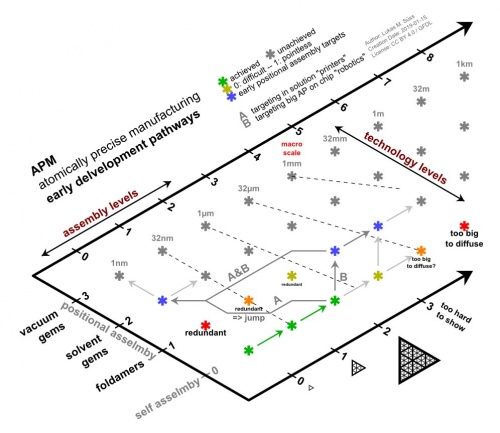Positional assembly redundancy blockade
It would be nice if we could go to more advanced materials as soon as possible.
Climbing the technology levels as soon as possible that is.
Straight along the left axis if the diagram.
But there is an obstruction.
The "Positional assembly redundancy blockade".
Stars marked with "redundant".
Contents
[hide]Relation to pathways
Direct path - no such blockade
One of course can try the direct path, which has it's severe challenges.
But also it has it's merits since there is no other way to create such advanced material right away other than positional assembly. The direct path leapfrogs the "positional assembly redundancy blockade"
Incremental path - the bockade is present
Within the incremental path there is a "positional assembly redundancy blockade" though. Meaning an specific sub-area in the space of possible technological evolutions where all what positional assembly could do can be done with self assembly just as easy if not much easier.
Q: When is one running into the positional assembly redundancy blockade?
A: When trying to do positional assembly right away with still small pre-self-assembled / pre-self-folded building blocks.
Q: Why is one running into the positional assembly redundancy blockade then?
A: Because such small pre-selfassembled stuctures are well capable of encoding their target position in their own surface structure. As such all assembly that can be done with positional assembly can be done with self-assembly too. Just easier.
Q: So what's the advantage of positional assembly then?
A: The main reason we want to go for positional assembly so hard is that there are higher performance materials (gemstones and small stiff molecule building blocks) that just simply cannot encode the target position of their constitute parts in the the surface of their constitute parts since the surface is too small.
In the extreme: One cannot carve the "surface of an atom" to be shape complementary to an other atom.
All atoms of the same element are exactly identical and indistinguishable.
Overlooking isotopes which is irrelevant for chemical surface properties.
Relation of the blockade to various development path approaches
(wiki-TODO: review this section - feels like there are some mix-ups in there)
Bottom up positional assembly
- The robo approach. It evades the redundancy blockade the most, making a wide detour around the blockade.
- The printer approach. It evades the blockade more minimalistically.
- The catalysis construction kit approach. It runs darn hard into the blockade.
Bottom up positional assembly just does not really work yet this early. (The infamous fat finger problem.)
Top down positional assembly
- The robo approach from the other side, again evading the blockade by wide margin. MEMS gripper manipulation of very very big self-assemblies.
- Trying to assemble sturdier kinds of foldamers (like e.g. de-novo proteins) by means of scanning probe microscopy. This runs quite hard into the barrier. There are some similarities in directness to the direct path. While maybe easoer then the direct path, there should still be way easier methods using further scaling of self-assembly.
- The direct path. As mentioned this would entirely leapfrog the barrier.
